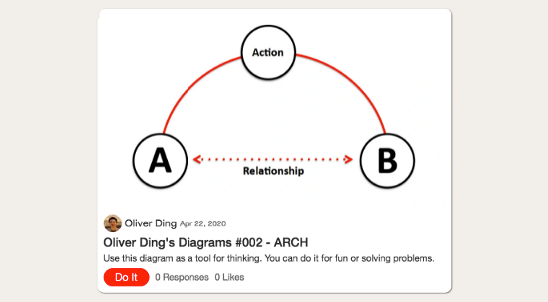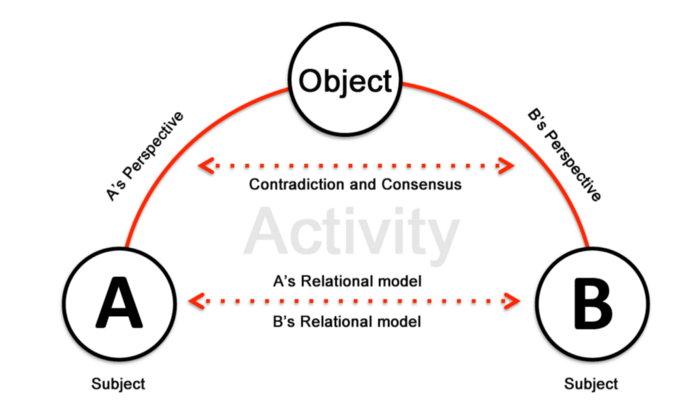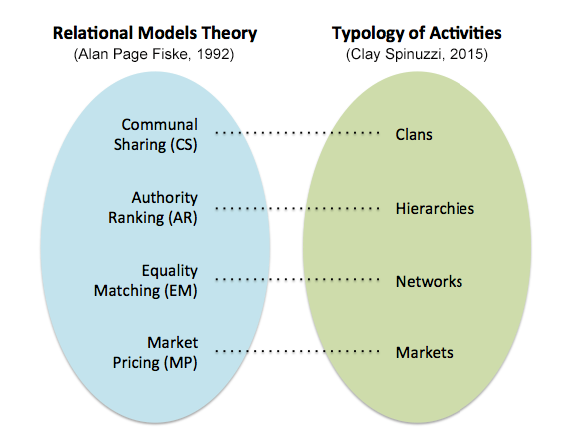The ARCH Diagram

A diagram for discussing conflict, consensus, and intersubjectivity

Several years ago, I designed the above diagram for discussing social design. Later, I realized that it can be used for discussing conflict, consensus, and intersubjectivity in general.
In 2020, I used the ARCH diagram to curate Alan P. Fiske's Relational Models Theory and Clay Spinuzzi’s typology of Activity. See the diagram below.

This article introduces Clay Spinuzzi’s typology of Activity and Alan P. Fiske's Relational Models Theory, then returns to the above diagram to discuss the outcome of thematic curation.
Clay Spinuzzi’s typology of Activity
In 2014, I started learning Activity Theory. After reading some books and papers about Activity Theory, I moved to search for some typologies of activities. In 2015, I found Clay Spinuzzi’s paper Toward a Typology of Activities: Understanding Internal Contradictions in Multiperspectival Activities. He pointed out, “AT (Activity Theory) currently lacks a suitable typology for characterizing ideal types of activities in terms of multiperspectivity, so it has had trouble systematically characterizing the resulting sets of internal contradictions.”
He proposed a new matrix with the following two dimensions:
- How is the object defined? Is it defined explicitly and deductively or tacitly and inductively?
- Where is the object defined? Is it defined within the activity’s division of labor or outside it?
The outcome is a matrix with four quadrants (see the diagram below) which represent four ideal activity types.

Spinuzzi named these four ideal types of activities as Hierarchies, Markets, Clans, and Networks. We have to notice these words are just names of ideal types. Spinuzzi said, “I use the term markets in the sense of most organizational typologies (e.g., Adler & Heckscher, 2007; Boisot & Child, 1999; Boisot et al., 2001; Cameron & Quinn, 2011; Ouchi, 1980; Ronfeldt, 2007), not strictly in the sense of commerce. Clan may be too precise; I prefer Adler and Heckscher’s (2007) ‘community.’ But the term community already denotes a different concept in activity theory.”
You can find more details in A Typology of Activities [Activity Theory].
Alan P. Fiske's Relational Models Theory
In 1992, Alan P. Fiske published a paper titled The Four Elementary Forms of Sociality: Framework for a Unified Theory of Social Relations on Psychological Review. Fiske argued that people in all cultures use just four relational models to generate most kinds of social interaction, evaluation, and affect.
These four models are Communal Sharing (CS), Authority Ranking (AR), Equality Matching (EM), and Market Pricing (MP). In communal sharing, people treat all members of a category as equivalent. In authority ranking, people attend to their positions in a linear ordering. In equality matching, people keep track of the imbalances among them. In market pricing, people orient to ratio values.
In a broad sense, these four modes roughly match Spinuzzi’s four ideal types of activities (see the diagram below).

Are they saying the same thing with different words?
A major difference is that these two frameworks work on two levels, Relational Models Theory is about individual psychological models while Typology of Activities is about collective activities. The former is an actor-centered perspective while the latter is an activity-centered perspective.
Fiske used “Four Elementary Forms of Sociality” to describe these four relational models, but he used “4 psychological models” to describe them. Is his framework for describing patterns of interactions or subjective mental thinking? Fiske said, “People construct complex and varied social forms using combinations of these models implemented according to diverse cultural rules. People’s chief social conceptions, concerns, and coordinating criteria, their primary purposes, and their principles, are usually derived from the four models; they are the schemata people use to construct and construe relationships.” It seems these four models are subjective mental thinking.
However, Fiske also claimed these models also are types of relationships. For example, “Communal Sharing (CS) is a relationship in which people treat some dyad or group as equivalent and undifferentiated with respect to the social domain in question…In Authority Ranking (AR) people have asymmetric positions in a linear hierarchy in which subordinates defer, respect, and (perhaps) obey, while superiors take precedence and take pastoral responsibility for subordinates…In Equality Matching (EM) relationships people keep track of the balance or difference among participants and know what would be required to restore balance…Market Pricing (MP) relationships are oriented to socially meaningful ratios or rates such as prices, wages, interest, rents, tithes, or cost-benefit analyses.”
I consider these four models are both basic psychological models and ideal types of social relations. The trick here is three levels of explanation: the level of psychological thinking, the level of interaction, and the level of relationship (Fiske didn’t distinguish these different levels, this is my explanation). At the basic level, there are only four elementary forms of psychological thinking. At the higher level, there are many types of social interactions that require more than one actor. Each actor has his own relational models for a particular interaction. If two people adopt the same type of relational model — for example CS — for a particular interaction, then we can say this is a CS type of interaction. If there are many CS types of interactions between two people, then we can say these two people are in a CS type of relationship.
For any typology, types are the basic thing. However, the secret of adopting a typology is not knowing types, but using types to understand dynamics between types. The following section will put Fiske’s model and Spinuzzi’s framework together and discuss this issue further.
Multiperspectivity, Contradictions, and Relationship
Activity theorists often talk about “multiperspectivity” and “contradictions”. Spinuzzi (2015) said, “Activities are multiperspectival in that different people who are involved in the same activity tend to perceive different aspects of it and consequently tend to pulse the shared object in different ways, with different tempos, using different configurations of the resources.”
Fiske also pointed out the conflict in social life, “What is crucial isn’t just that there are four ways in which we relate to each other. It’s that misunderstandings and conflict in social life occur because two of us are using different models, or using the same model in different ways. Interacting with co-workers, spouses or neighbors, we take it for granted that the other person is using the same model we are. Often we are wrong.” (Source: Basic Relationships)
Based on a meta-diagram called ARCH, I drew the diagram below to combine Fiske’s model and Spinuzzi’s framework for our discussion.

The above diagram represents a basic joined action with two people: person A (subject A) and person B (subject B).
- Following Activity theory’s terms, this action is part of a collective activity with a shared Object. Subject A and Subject B have their own perspectives on the Object, these perspectives may generate contradictions or consensus.
- For Relational Models Theory, it doesn’t have the term “object”, Fiske just directly talked about social interactions and social relationships. Person A and person B have their own relational models for a particular interaction. These difference models might generate contradictions or consensus too.
Spinuzzi said, “In a complex collective activity, different stakeholders may have different motives and perspectives on the shared object. In any collective activity, an object is ‘‘multifaceted, evolving,’’ and even ‘‘dialogical’’, understood differently by different participants at different points, developing over time. Activities become polycontextual and polymotivated; stakeholders become more heterogeneous…Activity theorists have recognized this issue of multiperspectivity and its resulting internal contradictions. Such contradictions may become more prevalent and important as activities become more connected and interpenetrated. In response, activity theorists have attempted to describe different types of activities in order to better characterize such internal contradictions.”
Activity theorists don’t talk about “relationship” directly, they like “contradictions” because it drives the development and transformation of activity. According to Nicolini (2012), “…the (activity) theory addresses the traditional opposition between change and stability. One of the great merits of the theory is to provide strong support to the idea that, from a practice-based perspective, change and not stability is primordial.” (p.118)
Fiske paid attention to similar contradictions, but more to individual personal behavior and emotion. He said, “One member of a work team assumes implicitly that it is a matching operation — each person on the team should contribute equally. But others assume the task is a shared responsibility of the group as a whole, so everyone should simply pitch in and do whatever is necessary. The sharers are offended when the matchers keep precise track of how much each person does. The matchers get angry when the sharers fail to take regular turns, or when one sharer does extra work and the matchers don’t try to keep up. Everyone is doing something reasonable and legitimate, but people offend each other because they are operating with different models. It doesn’t occur to them that the others have different unstated assumptions about how to coordinate.”
Fiske also used marriage as an example to discuss conflicts, “One spouse is a pricer. He assumes household repairs and cooking should be done in the most efficient way possible. Whoever can do a task quickest ought to take care of it. The other spouse is a matcher. She assumes work should be divided equally into matching tasks. The pricer gets irritated when the matcher tries to take a turn doing jobs she can’t do quickly or well. It seems to him inefficient and silly. The matcher is hurt that the pricer doesn’t take turns cooking and doesn’t appreciate her trying to pitch in on electrical repairs. Both are trying to be responsible (acting in accord with the model they take for granted.) Neither can understand why the other one fails to do what makes sense.”
This example is about conflicts on “division of labor” which is a term of activity theory. Now, we can say these two frameworks can work together. Spinuzzi’s typology is more about collective configurations of activity while Fiske’s framework is more about individual moral intuitions on social interaction.
